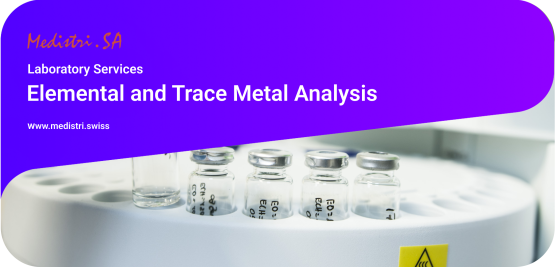(Download: Elemental and Trace Metal Analysis in PDF by Medistri)
Elemental Composition and impurity quantification testing services from GMP laboratories strengthen pharmaceutical development and GMP production — One of the support is Elemental and Trace Metal Analysis. For pharmaceutical manufacturers, Elemental and Trace Metal Analysis is an important step towards development, quality control, and release.
Elemental and Trace Metal Analysis is a critical part of quality control and commercial release in the pharmaceutical and medical device industry. It involves the analysis of trace metals and other elements in raw materials, active pharmaceutical ingredients (APIs), excipients, and formulations to ensure product quality and purity.
Elemental and Trace Metal Analysis is important in the pharmaceutical and medical device industry because it helps to ensure the quality and purity of the products. Through Elemental and Trace Metal Analysis, we’re able to detect potential unknown toxic compositions and it can also have an influence on the stability of the formulations and impact catalysis degradation.
👉 The analysis of elemental impurities is necessary to describe the concentration of trace elements in final drug products.
One of the most common product analytical tests includes the toxic heavy metals such as As, Hg and Pb. In addition to measuring the starting materials it is essential to measure all finished products and in some cases intermediates, to demonstrate the compliancy with the various regulations.
US Pharmacopeia General Chapters <232> and <233> describe wet chemistry procedures for the analysis of heavy metal elemental impurities in pharmaceuticals.
Usually, the source of elemental impurities include:
- Residual catalyst or inorganic reagents added in synthesis.
- Contamination from manufacturing and process equipment.
- Leaching from container closer systems.
- Impurities added in the preparation of the drug product.
Elemental and Trace Metal Analysis is performed using several analytical techniques, including inductively coupled plasma – mass spectrometry (ICP-MS), inductively coupled plasma – optical emission spectroscopy (ICP-OES), ion chromatography (IC), flame atomic absorption spectroscopy (FLAA), and X-ray fluorescence (XRF). These techniques are used to provide a strategic approach to sample preparation for difficult samples and to cover almost the entire periodic table from trace levels to percent levels.
The choice of technique depends on the specific requirements of the analysis, such as the elements to be measured, the concentration range, and the matrix of the sample. For example, ICP-MS is a highly sensitive technique that can measure trace elements at very low concentrations, while ICP-OES is better suited for measuring higher concentrations of elements. The sample preparation process is also an important part of trace elemental analysis and can involve digestion, extraction, or other methods to prepare the sample for analysis.
👉 Chapter <232> specifies limits for the amounts of elemental impurities in drug products, including catalysts and environmental contaminants that may be present in drug substances, excipients, or drug products.
👉Chapter <233> describes analytical procedures for the evaluation of elemental impurities that are suitable for the limits described in Chapter <232>. These procedures include two methods and criteria for the acceptability of alternative procedures.
The choice of method depends on the specific requirements of the analysis, such as the elements to be measured, the concentration range, and the matrix of the sample.
Medistri’s in-house GMP laboratory works with its customers to design pharmaceutical organic and inorganic elemental analysis.
🎯 To learn more about Medistri’s Elemental and Trace Metal Analysis, visit on our website here or directly contact our team at contact@medistri.swiss.
- The Medistri Team
#Medistri
